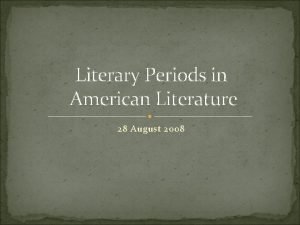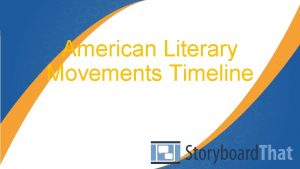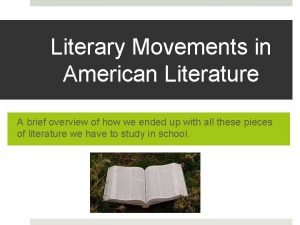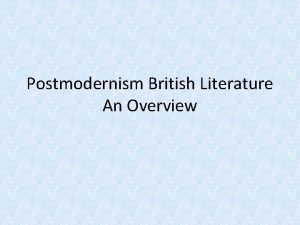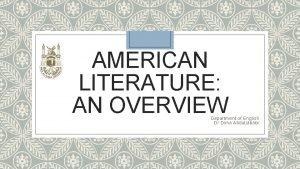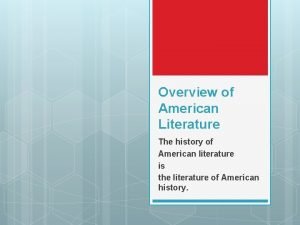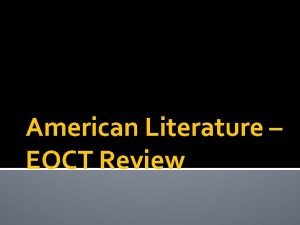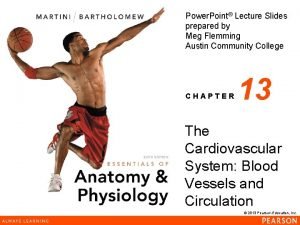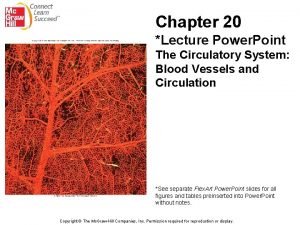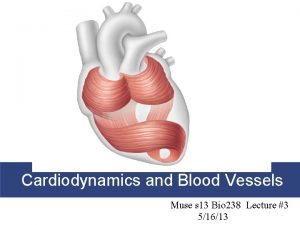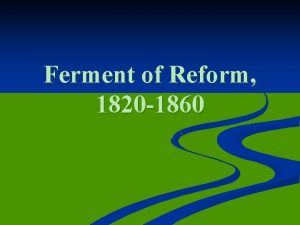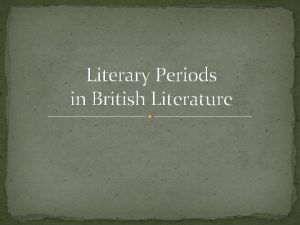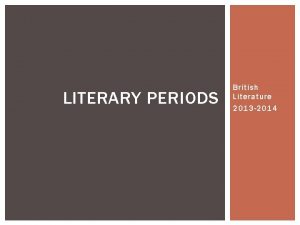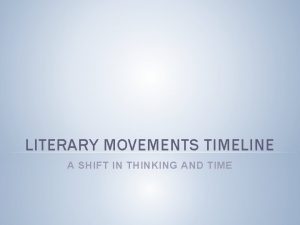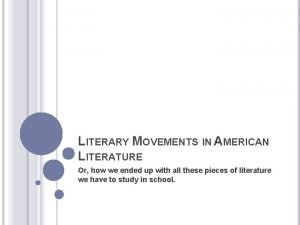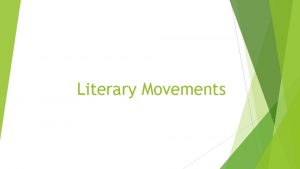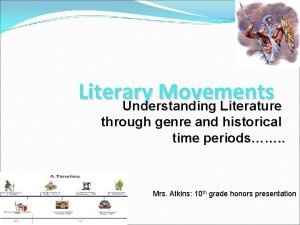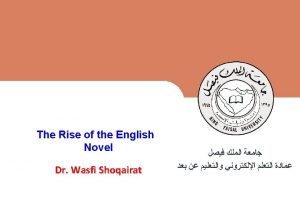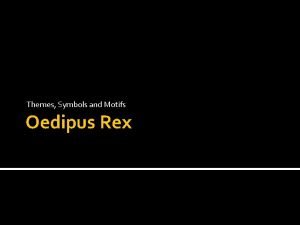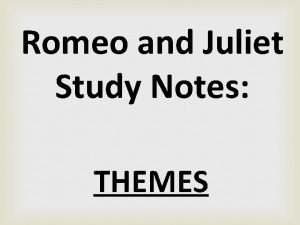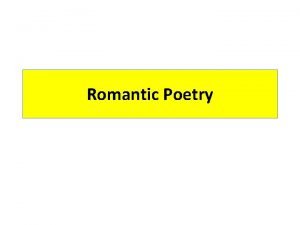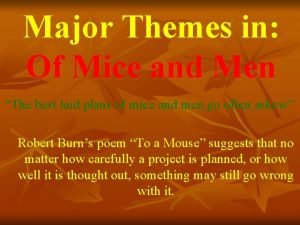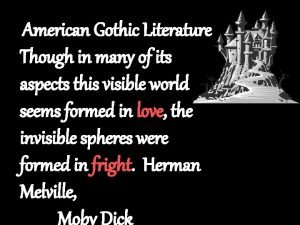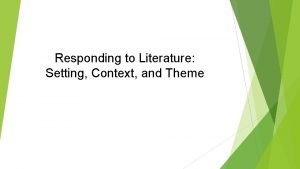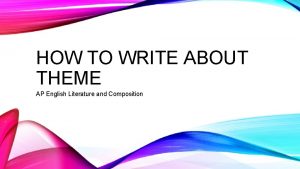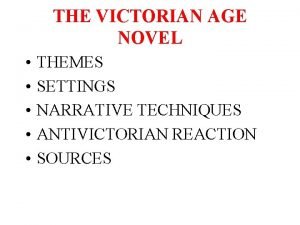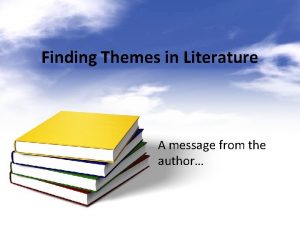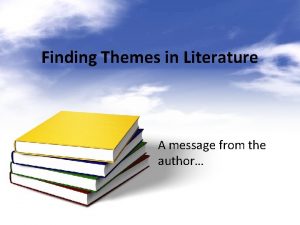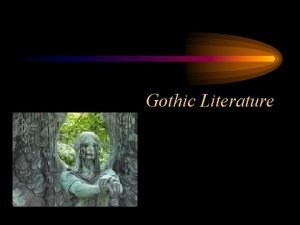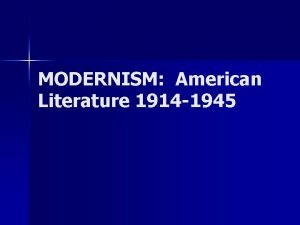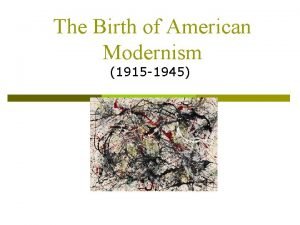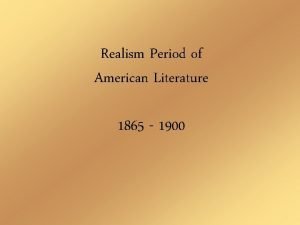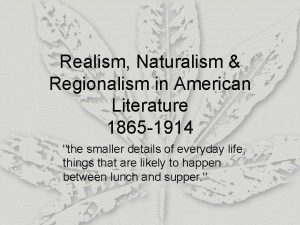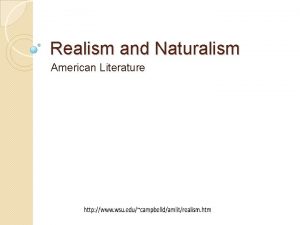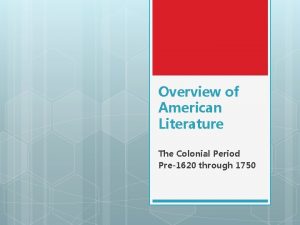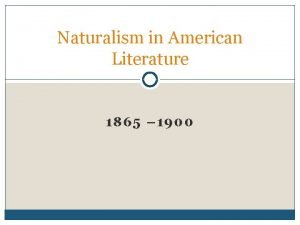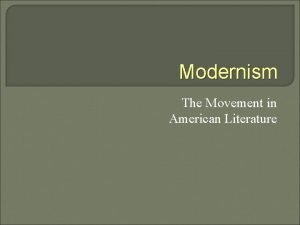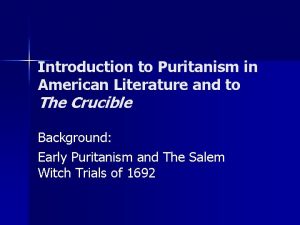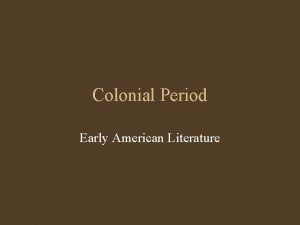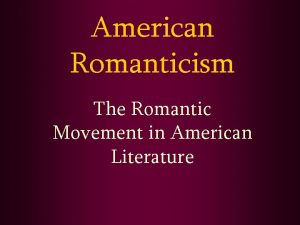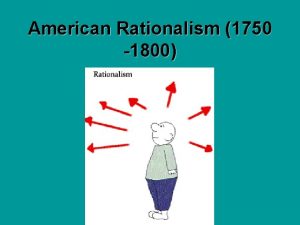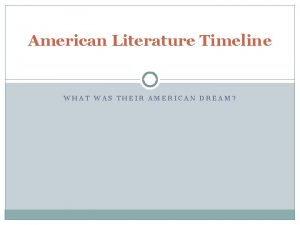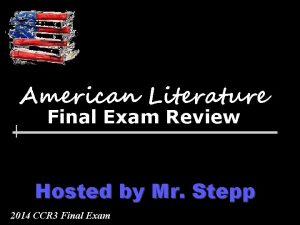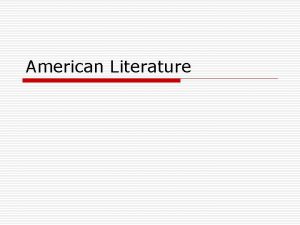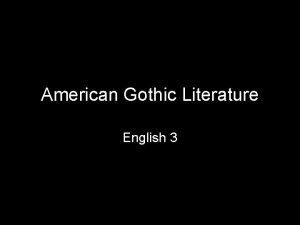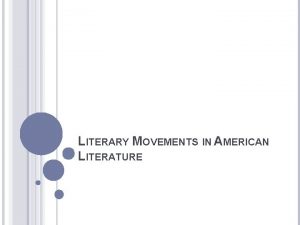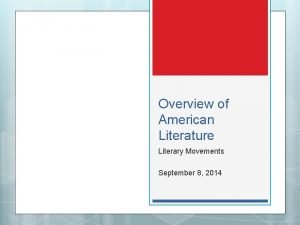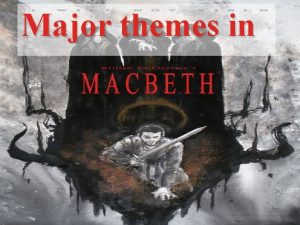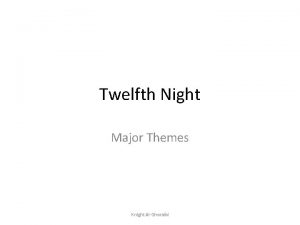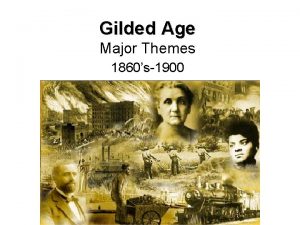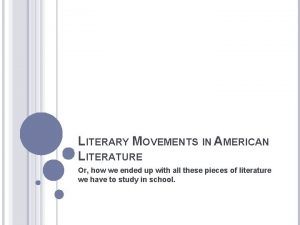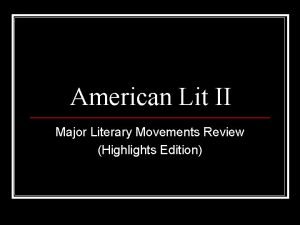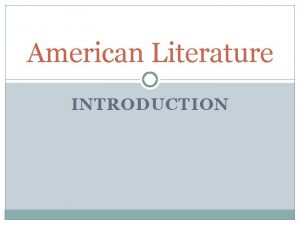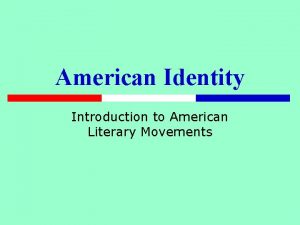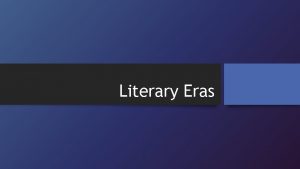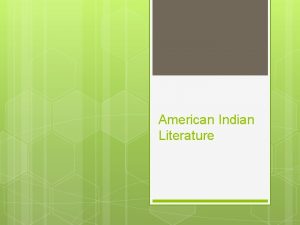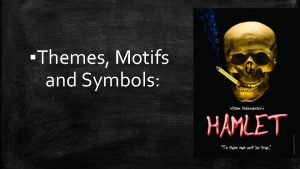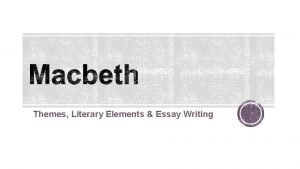Overview of American Literature Literary Movements Major themes




















































- Slides: 52

Overview of American Literature Literary Movements

Major themes in American Literature American Also individualism known as the self-made man Celebration of ambition and achievement Original colonists came for religious freedom Later colonists came looking to make their fortune with opportunities not available in classbased European societies.

Major themes in American Literature The American Dream Closely linked to American individualism The idea that anyone can become whatever he or she wants to become through hard work, determination, and perseverance

Major themes in American Literature Cultural diversity A society that welcomes legal immigrants of diverse backgrounds The melting pot theory—Immigrants assimilate into our culture and become Americans The salad bowl theory—immigrants retain their separate identities while making up part of the whole and adopt a hyphenated American name (Chinese-Americans, for example)

Major themes in American Literature Tolerance Religious tolerance was one of the first principles in American life. More recent issues have included race, gender, sexual orientation, etc.

The Native American Period (pre-1620)

Native American Period (pre-1620) Oral tradition of song and stories Original authors unknown Written accounts come after colonization Includes: creation stories, myths, totems Archetypes: trickster and conjurer Focuses The on: natural world as sacred Importance of land place

Native American Period (pre-1620) Myth – an anonymous oral story Relies on the supernatural to explore a natural phenomenon, human behavior, or mystery Explain why the world is the way it is/they help make sense of the world

Native American Period (pre-1620) Notable “The Works: Earth on the Turtle’s Back” “When Grizzlies Walked Upright” “Grandmother Spider Steals the Sun” “Creation by Women”

The Colonial Period (1620 -1750)

Historical Context Colonial Period (1620 -1750) When colonists arrived in the new land, they created villages and towns and established new governments (while protesting the old ways in Europe) French, Swedes, Dutch, German, Scots-Irish, Spanish, Africans (mostly slaves) Did not consider themselves “Americans” until mid-1700 s Enormous displacement of Native-American civilizations

Historical Context Colonial Period (1620 -1750) of the period was dominated by the Puritans and their religious influence Literature Emphasis on faith in one’s daily life Predestination- A person’s fate is determined by God Original Sin- All are corrupt and need a Savior Puritan work ethic—belief in hard work and simple, no frills living Theocracy—government ruled by Bible/church

Characteristics Colonial Period (1620 -1750) Types of Writing Sermons Writing Diaries Personal Writing Style is Utilitarian not professional writers Narratives Writing in instructive Puritan Plain Style Simple and direct

Important Authors Colonial Period (1620 -1750) Representative Authors: William Bradford (journal) Anne Bradstreet (poetry) Jonathan Edwards (sermon) Mary Rowlandson (captivity narrative) Phillis Wheatley (poetry) Olaudah Equiano (slave narrative) Though not written during Puritan times, The Crucible by Author Miller & The Scarlet Letter by Nathaniel Hawthorne depict life during the time when Puritan theocracy prevailed.

Colonial Period (1620 -1750) Art

Art Colonial Period (1620 -1750) American Progress John Gast

Revolutionary Period (1750 -1815)

Historical Context Revolutionary Period (1750 -1815) Occurred during/after the Revolutionary War Writers focused on explaining and justifying the American Revolution Writers pondered what it really means to be an American After the War of 1812 (when last British troops were removed from North America) there was an even greater focus on nationalism, patriotism, and American Identity

Characteristics Revolutionary Period (1750 -1815) Emphasis on reason as opposed to faith alone; this was a reaction to the Puritan way of life Shift to a more print-based culture; literacy seen as a sign of status Instructive in values, highly ornate writing style; highly political and patriotic

Important Authors Revolutionary Period (1750 -1815) Representative Benjamin authors: Franklin (biography, common sense aphorisms) Patrick Henry (speech) Thomas Paine (pamphlet) Thomas Jefferson (political documents) Abigail Adams (letters)

Art Revolutionary Period (1750 -1815)

Art Revolutionary Period (1750 -1815)

Romanticism (1800 -1865)

Historical Context Romanticism (1800 -1865) A reaction to the previous decades in which reason and rational thought dominated Period of invention, Manifest Destiny, abolition movement, and the “birth” of truly American Literature Growth of urban population in Northeast Growth of newspapers, lectures, debates Revolution in transportation and science Industrial revolution made “old ways” of doing things irrelevant

Characteristics Romanticism (1800 -1865) Writers celebrated: Individualism Nature Imagination Creativity Emotions Interest in fantasy and supernatural Writing can be interpreted two ways—surface and depth Good triumphs over evil Imagination over reason Intuition over fact Types of writing: Short Stories Novels Poetry

Important Authors Romanticism (1800 -1865) Early Romantics Authors began the tradition of creating imaginative literature that was distinctly American Washington (folktales) William (poetry) James Irving Cullen Bryant Fenimore Cooper (novels)

Important Authors Romanticism (1800 -1865) Fireside Poets The most popular poets of the time were read in the home by the fireside Poetry contained strong family values and patriotism Taught in elementary schools for memorization Poets Henry Wadsworth Longfellow Oliver Wendell Holmes James Russell Lowell John Greanleaf Whittier

Important Authors Romanticism (1800 -1865) Transcendentalists Hippies of the Romanticism Belief that man’s nature is inherently good; “divine spark” or “inner light” Man and society are perfectible (utopia) Stress individualism, selfreliance, intuition Authors Ralph Waldo Emerson (essays, poetry) Henry David Thoreau (essays)

Romanticism (1800 -1865) Characteristics/Authors Dark Romantics AKA—Gothic or Anti. Transcendentalism Poets Nathaniel Hawthorne (novels, short stories) Herman Melville (novels, short stories, poetry) Edgar Allan Poe (short stories, poetry, literary criticism) Man’s nature is inherently evil Use of supernatural Strong use of symbolism Dark landscapes, depressed characters

Art Romanticism (1800 -1865)

Realism (1850 -1900)

Historical Context Realism (1850 -1900) The Realistic Period includes the Civil War, significant industrial inventions, and extensive westward expansion Rejection of Romantic view of life as too idealistic Writers write about real-life issues and complex events of the time rather than idealized people or places Objective narrator

Characteristics Realism (1850 -1900) Realistic authors convey the reality of life, however harsh Characters reflect ordinary people in everyday life: determined yet flawed, struggling to overcome the difficulties of war, family, natural disasters, and human weaknesses Good doesn’t always triumph over evil Nature is a powerful force beyond man’s control Racism persisted beyond slavery—Reconstruction, Jim Crow, KKK, etc.

Characteristics/Authors Realism (1850 -1900) Transitional Writers Transition from Romanticism to Realism Express Transcendental ideas in poetry, with realistic detail Experimented with new poetic techniques such as free verse and slant rhyme Authors Walt Whitman (poetry) Emily Dickinson (poetry)

Characteristics/Authors Realism (1850 -1900) Civil War Writers Primarily concerned with: The war Slavery Women’s suffrage (right to vote) Authors Abraham Lincoln Robert E. Lee Mary Chesnut Sojourner Truth Harriet Beecher Stowe Frederick Douglass

Characteristics/Authors Realism (1850 -1900) Local Color Writers (Regionalists) Focused on a particular region of the country Seeking to represent accurately the culture and beliefs of that area Emphasized: Physical landscape Habits Occupations Speech (dialect) of the area’s people Authors Mark Twain (Mississippi River valley) Kate Chopin (the South, particularly Louisiana) Willa Cather (the Midwest, particularly Nebraska)

Naturalism (1880 -1940)

Historical Context Naturalism (1880 -1940) Realism turned to Naturalism when literary writers were exposed to the views of three scientific/political works Charles Darwin—biological determinism Sigmund Freud—psychological determinism Karl Marx—socio-economic determinism Determinism—the belief that humans cannot be held morally responsible for their actions due to circumstances beyond their control.

Characteristics Naturalism (1880 -1940) Focused on grim reality Observed characters like scientists observe lab animals Viewed nature and the universe as indifferent, even hostile, to man Universe is godless, cold, and indifferent Life is meaningless Fate=Chance (no free will) Characters are helpless victims—trapped by nature, the environment, or their own heritage

Important Authors Naturalism (1880 -1940) Jack Edwin Stephen Ambrose London (novels, short stories) Crane (novels, short stories, poetry) Arlington Robinson (poetry) Bierce (short stories)

Modernism (1900 -1950)

Historical Context Modernism (1900 -1950) Writers World affected by: War I, World War II, fear of communism, beginning of the Cold War Roaring 20 s, the Great Depression, commercialism Increased population from immigration Lingering racial tensions Technological changes Fear of eroding traditions

Characteristics Modernism (1900 -1950) Modern writers are known for: Themes of alienation and disconnectedness Frequent use of irony and understatement Experimentation with new literary techniques in fiction and poetry Stream of consciousness Interior dialogue Fragments Creating a unique style Rise of ethnic female writers

Important Writers Modernism (1900 -1950) The Lost Generation A group of writers who chose to live in Paris after WWI Themes of alienation and change Confronted people’s fears, despair, and disillusionment Writers T. S. Eliot (poetry) F. Scott Fitzgerald (fiction) Ernest (fiction) Hemingway

Important Writers Modernism (1900 -1950) Harlem Renaissance Flourishing of African. American authors Included Two music and art goals: Write about African. American experience Create literature by African. Americans that could rival anything created by anyone else Writers Langston (poetry) Hughes Zora Neale Hurston (fiction) Claude (poetru) Mc. Kay

Important Writers Modernism (1900 -1950) Southern Renaissance Follow in the footsteps of earlier local color writers, in that they focus on the South Writers Margaret William Mitchell Faulkner Flannery O’Connor

Important Writers Modernism (1900 -1950) Traditional Poets Carl Sandburg Experimental Poets e. e. cummings Robert Frost Modern dramatists Arthur Miller Tennessee Williams

Postmodernism (1950 -present)

Historical Context Postmodernism (1950 -present) unprecedented prosperity global conflict Korean War, Vietnam War, the end of the Cold War, the rise of terrorism, Gulf War, 9/11, Iraqi War in Afganistan social protest the civil rights movement, the women’s rights movement, the gay rights movement mass culture and consumerism; media saturation rise of technology and space exploration the digital revolution

Characteristics Postmodernism (1950 -present) Eclectic—a collection of a little bit of everything Questions traditional values Create traditional works without traditional structure Often critical and ironic No heroes/anti-heroes are common Detached, unemotional Individuals are isolated Address social issues related to gender/race/youthful rebellion

Popular Authors Postmodernism (1950 -present) The Beat Poets Pre-hippies, highly intellectual, exuberant language and behavior Jack Kerouac William S. Burroughs Allen Ginsberg Confessional Poets Used anguish of their own lives to reveal hidden despair Sylvia Plath Anne Sexton Robert Lowell

Popular Authors Postmodernism (1950 -present) American Authors J. D. Salinger James Thurber John Updike Truman Capote Stephen King Joyce Carol Oates Multicultural Literature Jewish African-American Ralph Ellison, Maya Angelou, Alice Walker Latino-American Elie Wiesel Julia Alvarez, Sandra Cisneros Asian-American Amy Tan, Maxine Hong Kingston
 American literature period
American literature period American literary movements timeline
American literary movements timeline American literary movements
American literary movements Postmodernism in british literature
Postmodernism in british literature American literature overview
American literature overview American literature overview
American literature overview What is locomotor in dance
What is locomotor in dance Common themes in american literature
Common themes in american literature Pulmonary circulation
Pulmonary circulation Systemic veins
Systemic veins Arteries of abdomen
Arteries of abdomen Overview of the major systemic arteries
Overview of the major systemic arteries American reform movements between 1820 and 1860
American reform movements between 1820 and 1860 The georgian period 1910-1936
The georgian period 1910-1936 Time line of literary periods in british literature
Time line of literary periods in british literature Timeline of literary movements
Timeline of literary movements Literary movements in america
Literary movements in america What is literary movements
What is literary movements Literary movements
Literary movements Major themes in great expectations
Major themes in great expectations Symbols in oedipus
Symbols in oedipus Themes of romeo and juliet
Themes of romeo and juliet Diction in things fall apart
Diction in things fall apart Holy thursday
Holy thursday The best laid plans of mice and men poem
The best laid plans of mice and men poem All my sons theme of responsibility
All my sons theme of responsibility The others theme
The others theme The gothic novel characteristics
The gothic novel characteristics Setting in literature
Setting in literature A level english literature themes
A level english literature themes Victorian age themes
Victorian age themes Thematic idea examples
Thematic idea examples Finding themes in literature
Finding themes in literature Gothic vs romanticism
Gothic vs romanticism Literary modernism
Literary modernism American romantic era
American romantic era American modernism definition
American modernism definition Characteristics of literary realism
Characteristics of literary realism Realism regionalism and naturalism
Realism regionalism and naturalism Realism in american literature
Realism in american literature Realism and naturalism in american literature
Realism and naturalism in american literature American literature colonial period
American literature colonial period Themes of naturalism
Themes of naturalism Characteristic of modernism
Characteristic of modernism American puritanism literature
American puritanism literature Periods of american literature
Periods of american literature Periods of american literature
Periods of american literature American romanticism authors
American romanticism authors It is called the age of reason
It is called the age of reason American dream history timeline
American dream history timeline American literature final exam
American literature final exam Outline of american literature
Outline of american literature American gothic literature characteristics
American gothic literature characteristics
